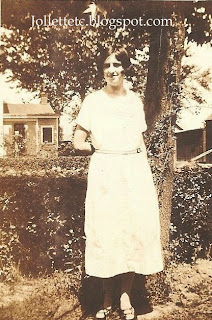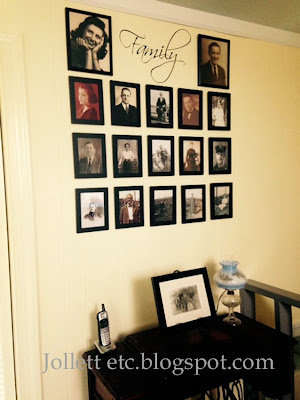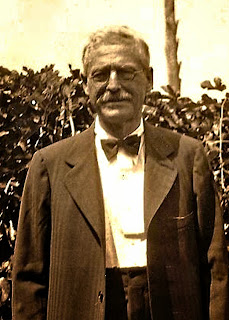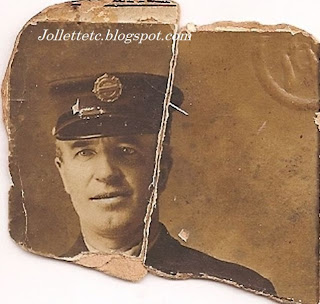Sepia Saturday challenges bloggers to share family
history through old photographs.
This week’s Sepia Saturday prompt is almost too
easy: damaged photos. Welcome to my
world. How much time do you have? Several boxes and five photo albums are
filled with damaged photos that keep me occupied for hours on end looking for
signs of familiarity, searching for clues to family relationships, and gleaning
insight into my family’s daily lives.
When I remodeled the bonus room over the garage this past
winter, I wanted to make it my “Gene Cave” (although the hubster has tried to
hijack it with a “Man Cave” big-screen TV and antler mounts). Bookshelves were
decluttered not just to HOLD the old albums and books of research, but also to
DISPLAY them artistically. They are fine, but the focal point of the room is
one wall reserved for old photos of parents, grandparents, and
great-grandparents.
As expected, some of my favorite photos are also the most
damaged. Wrinkles and creases, missing corners, mildew, stains and faded images
can be repaired with software like Photoshop. To restore a photo means to
repair those flaws in order to return it to its original appearance. I am no
pro when it comes to Photoshop, but I can remove random spots and stains; a
crease is easily erased as long as it doesn’t pass through anything intricate.
My brother-in-law, on the other hand, is a champ, so I put him to work
restoring several photos for “The Family Wall.”
However, there has been quite a bit of conversation in
the genealogy world about the ethics of photo editing. In one camp are those
who believe any alteration to a photo is wrong. They hold that wear and tear is
part of the life of a photo. They doubt anyone’s ability to assume or know what
the original even looked like. On the other side are those who want to preserve
old photos as a way to remember and honor their ancestors without the
distortions caused by stains and cracks. They argue that a photo with a “nice”
appearance is easier to understand and enjoy.
I side with those who favor restoration. How could anyone
not prefer the restored version of my lovely great-grandmother, Mary Sudie
Rucker?
Maybe because I have created so many traditional scrapbooks in which I cropped photos either to highlight a subject or simply to make it fit on the page, I’m rather cavalier when it comes to manipulating old photos. I think nothing of editing out a lot of sky as I did with this photo of my great-grandfather Walter Davis.
Did my use of the cropping tool ruin the picture? Purists
would say yes – just because we CAN do it doesn’t mean we SHOULD. However, I
disagree. I did nothing to alter the essence of the photo since whoever took
the picture (likely my grandaunt Violetta) was focusing on Walter, not the sky.
Truth be told, I would feel no guilt editing out that pole for the sake of aesthetics,
but I chose not to.

 This photo of my 2X great-grandfather James Franklin
Jollett could not be enlarged to fit in a 5x7 frame without cutting off his feet.
My brother-in-law deftly cloned some landscape in order to “stretch” the photo
to fit. Did we go too far in altering the geography of the photo? I do not know
what was REALLY there, and honestly, I do not care. Maybe I should, especially
if there was a historically significant building or person in the background. Since
I don’t know, I am comfortable assuming the background was just more of the
same.
This photo of my 2X great-grandfather James Franklin
Jollett could not be enlarged to fit in a 5x7 frame without cutting off his feet.
My brother-in-law deftly cloned some landscape in order to “stretch” the photo
to fit. Did we go too far in altering the geography of the photo? I do not know
what was REALLY there, and honestly, I do not care. Maybe I should, especially
if there was a historically significant building or person in the background. Since
I don’t know, I am comfortable assuming the background was just more of the
same.
This photo of my paternal grandmother Julia Slade is just bad. The dress is totally blown-out without a sign of detail. Was it a print fabric? Lace? Were there pin-tucks on the bodice? With enough time, my brother-in-law could have fashioned quite a nice dress, but even my cavalier sensibilities said no to that. Dress notwithstanding, it is the best photo of my grandmother as a young woman so it made the Wall.
In a seeming contradiction, I cannot be more pleased with
a restoration project than my brother-in-law’s masterful manipulation of the
one and only photo of my great-grandfather John Fleming Walsh. It is actually
two little cardboard chips, each smaller than a dime.
He “created” a jacket based on the clues in the photo. He also straightened John Walsh’s head, probably out of necessity to align with the collar. Of all the restorations, this one probably pushes the boundaries, but I have no objections. The coat seems true to the original.
Maybe I’m wishy washy. Maybe I simply rationalize in
order to feel good about my decisions. But I hope I am faithful to some rather conservative
standards for photo restoration:
- Scan photos at a high resolution and save in TIFF format as a digital master.
- Save any alterations including changing the color, cropping, or applying more sophisticated techniques such as removing stains and creases as JPEGs with unique names.
- Stay true to the original as much as possible. That is, avoid the temptation to Photoshop something in or out that would significantly change the truth (for example, adding a person to a group shot, deleting a cigar from someone’s hand).
- Consider how changes to a photo might change the story.
Please visit the Sepia Saturday “family wall” of
bloggers, of whom none have been digitally altered.
© 2015, Wendy Mathias.
All rights reserved.









B%2BX.jpg)
This month, I plan to help my mother scan old family photos. Thanks for the tips. I plan to have a file which will be true to the original for all. But many photos can be enhanced.
ReplyDeleteThat's a good project.
DeleteThe only change I'm not keen about is that last one of your great-grandfather. Too much was altered there - the face shape changed and he lost part of an ear for a couple of reasons & somehow the new tint doesn't appeal. But that's just me. I think you or your brother did excellent work on the others. Actually, there should be no argument about whether to fix an old photo or not. You're changing or enhancing a scanned image, so when you frame it, put the original behind it. If it's put in an album, include the original alongside it.
ReplyDeleteIn his defense, my brother-in-law didn't spend as much time on that photo as he could have and even he admits there's more to be done. I think he sensed a bit of pressure from me to complete my wall.
DeleteI like the idea of putting the original somewhere, either behind or next to in an album. One could even have a photo totally made up of the originals.
ReplyDeleteGood idea~
DeleteIt's a matter of personal preference, I think, Wendy. Most of us have an "instinct" that holds true -- we alter (or enhance) in ways that please us and most likely draw the line before altering too much. I like Gail's and Kristin's suggestions, though; it's important to keep the originals!
ReplyDeleteI have no problem with the created fireman's coat because they were standard; it was easy to find a coat for a fireman in Portsmouth early 1910s. So that creation is accurate anyway.
DeleteYour standards for photo restoration align up with mine, but I sure don't have the expertise of your brother-in-law!
ReplyDeleteI don't have the skill either.
DeleteI like how you restored them; I would favor more restoration than just keeping them in the original form, but then I don't do a lot with genealogy; I just think they look better restored.
ReplyDeletebetty
On my blog I typically use the non-restored photo and think nothing of it. Old photos are old photos, stained and wrinkled over time -- just like the rest of us. HA!
DeleteAs long as you are not ruining or altering the original, it really doesn't matter how much you alter them digitally. In the case of your 2X great-grandfather James Franklin Jollett, I think it would be better to make a mount with a narrower opening instead of extending the landscape.
ReplyDeleteThe only reason I didn't do what you're suggesting is to make the photos uniform in the wall display. I have other photos I could have used for him, but I just love how he's sitting.
DeleteA great post with lovely examples of the pros and cons of photo enhancement. I do like to use enhancement to clarify details of older photographs, but naturally keep the originals - except in the case of my gg grandfather's cracked glass print which I've disposed of, not without regret, but because I had a digital photos of it 'before and after' renovation, but I can blame my husband for urging me to throw it out
ReplyDeleteYou can't keep everything. I have glass portraits too that will be of no interest or value to my children - what to do? I just don't know.
DeleteI haven't altered any of my photos and while I would like to claim it is because I am a purist, the reality is, my skills in this department are sorely lacking. I think it is a case by case issue but I would definitely keep the old one around. (Wish someone could fix my Driver's license photo!)
ReplyDeleteI am lacking too!
DeleteI tend to digitally enhance scanned photos where it makes the subject easier to see. I admire the restoration work you have done. In my view if you are happy with what has been done, who am I to to complain.
ReplyDeleteI am happy with the results. I have no ulterior motives other than a pleasing display.
DeleteWendy, your photos have been restored quite beautifully. On the one hand, I definitely support photo restoration (and intend to pursue it myself) as long as the integrity of the composition is not compromised. And I agree that creative license is required for many images that have suffered damage. I do, however, like the idea of displaying both images before-and-after-style. What I don't care for is photo enhancing -- the act of adding irrelevant elements. Some people (raising hand) just like to see the original photo and all its marks. And just for the record, your brother-in-law's idea to create a jacket based on clues in your great-grandfather's photo falls under the creative license category as far as I'm concerned.
ReplyDeleteI don't mind damaged photos -- really, I don't. I have plenty and use them in that state for my blog. While yes, the fireman's coat is a creation, it's based on photos of firemen in our area at the time (1910s). It would have been a standard coat that he was likely to have worn. On the other hand, we could have found any number of dresses with flowers or checks, pleats, and lace true to the period, but that level of creation really would be far less likely to be accurate.
DeleteI like the idea of saving the original and displaying both. The only disadvantage I can see of cropping is when "clues" in the background might be eliminated - should sleuthing be necessary. Thanks for the guidelines...I didn't know the value of saving a TIFF master.
ReplyDeleteGood point about the clues - another good reason to save the original or scan of the original.
DeleteWhen the ancient light came through the camera lens the film captured a negative image that had to be chemically processed and then reproduced onto special paper. Digital scanning that faded cracked photo is only interpreting the original art, as only the first negative is the actual record of the moment the shutter clicked. Reproducing a photograph in the medium of a computer doesn't destroy anything so the only question is whether it is historically correct. So unless you erased your grandfather's mustache or added a flying saucer into the background, the digital improvements are about using the technology to find the details that might otherwise be lost.
ReplyDeleteYes, I agree. If I really wanted to change history, I'd get my brother-in-law to Photoshop Annette Funicello into my birthday party.
DeleteExcellent standards to work by, Wendy. Thanks for sharing both your photo rescues and your thoughts about the issues.
ReplyDeleteI appreciate the feedback from everyone.
DeleteWhen I think about altering scanned photographs I remember than even a scan, no matter how well done, may not be exactly like the photograph scanned. I don't have any problem enhancing old photographs to be able to clearly see the people in them better, or the background, or whatever the photo has to offer. And, like you, Wendy, I save the original scan as a TIF file and then note the edits when I save it again, either as a TIF or a JPG file.
ReplyDeleteYour family wall looks great. Are the photos eight-by-tens or some other size? Did you have them printed commercially or print from home? If from home, what kind of printer?
The two of my parents at the top are 8x10 but the rest are 5x7. I printed them at Shutterfly.
DeleteI like reading your thought on when and how much to "restore." Although I am more a "seat of my pants" in this department, I think our views are quite similar.in this department. Several years ago, I found a n online newspaper clipping of my paternal grandmother's parents. They were standing in front of the house he built after arrived in America. The pixels were so far apart that you could see between them -- but I kept that photo, as though it were in a gilded frame. Then about 3 years ago, I went to a Foss family reunion where I showed the the photo to folks. Lo and behold, one woman told me that she had the original and that she would mail a copy to me. I had that photo photoshopped in a heart beat. To see their faces was amazijng, and the detail on the house. Wish I were better at photoshop, but I do have my connections.
ReplyDeleteI use Photoshop to improve the photos of my ancestors. I'm not an expert by any means. I wish I were, but that would take more time to master Photoshop. I feel that as long as we keep the original copy and change the name of the altered photo to indicate that it's been altered, then it's all good. Nice post Wendy!
ReplyDelete